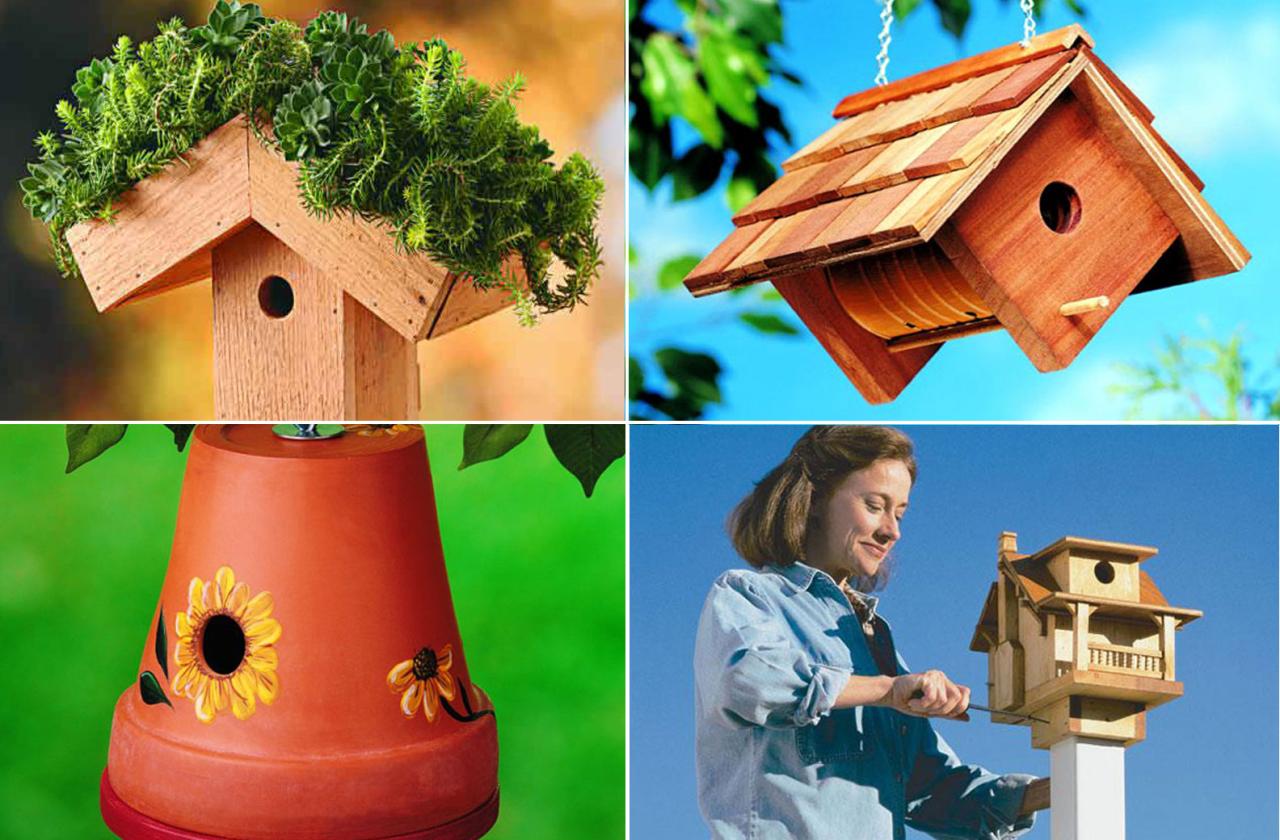Diy bird house – DIY birdhouse is a rewarding project that offers a chance to connect with nature while providing a safe haven for feathered friends. Building a birdhouse can be a fun and educational experience, allowing you to learn about different bird species, their nesting habits, and the importance of habitat conservation. This comprehensive guide will walk you through the steps of designing, building, and maintaining a birdhouse, empowering you to create a welcoming home for birds in your backyard.
From choosing the right materials and tools to understanding birdhouse design principles, this guide covers everything you need to know to create a birdhouse that attracts and supports birds. Whether you’re a seasoned DIY enthusiast or a beginner looking for a new project, this guide provides practical tips and insights to help you build a successful birdhouse.
Birdhouse Design
Designing a birdhouse is an enjoyable and rewarding experience. It’s a great way to attract birds to your garden and provide them with a safe and comfortable nesting space. However, creating a successful birdhouse requires careful consideration of the specific bird species you want to attract.
Designing for Specific Bird Species, Diy bird house
When designing a birdhouse, the most important factor is to consider the specific bird species you want to attract. Different bird species have varying sizes, nesting habits, and preferences. For example, a birdhouse for a bluebird will be significantly different from one designed for a chickadee.
Here are some factors to consider when designing a birdhouse for a specific bird species:
- Size: The birdhouse should be large enough to accommodate the bird’s size and nesting material.
- Entrance Hole Size: The entrance hole should be the appropriate size for the bird species. A hole that is too large may allow predators to enter, while a hole that is too small may prevent the bird from entering.
- Nesting Material: Some birds prefer to use specific nesting materials. For example, bluebirds prefer to use soft materials like grass and feathers, while woodpeckers prefer to use wood chips.
- Location: The location of the birdhouse is also important. Some birds prefer to nest in shady areas, while others prefer to nest in sunny areas.
For example, a bluebird house should have a 1.5-inch entrance hole, be 6 inches wide, 8 inches deep, and 6 inches tall. It should be placed in a sunny location with a clear view of the surroundings.
Unique Architectural Features and Decorative Elements
Beyond the basic considerations for bird species, you can add unique architectural features and decorative elements to your birdhouse design. These features can enhance the birdhouse’s aesthetics and provide additional benefits to the birds.
Here are some examples:
- Perches: Adding perches around the entrance hole can provide a resting spot for the birds.
- Roof Overhang: A roof overhang can help protect the entrance hole from rain and snow.
- Ventilation Holes: Ventilation holes in the back or sides of the birdhouse can improve air circulation and prevent the buildup of moisture.
- Decorative Elements: You can add decorative elements like carvings, paint, or stained glass to personalize your birdhouse.
Remember to choose materials that are safe for birds and the environment. Avoid using toxic paints or glues.
Birdhouse Design Table
Here is a table showcasing different birdhouse designs with their respective dimensions and features:
| Bird Species | Entrance Hole Size | Width | Depth | Height | Features |
|---|---|---|---|---|---|
| Bluebird | 1.5 inches | 6 inches | 8 inches | 6 inches | Perch, roof overhang, ventilation holes |
| Chickadee | 1 inch | 4 inches | 6 inches | 4 inches | Perch, roof overhang |
| Downy Woodpecker | 1.25 inches | 6 inches | 8 inches | 6 inches | Ventilation holes |
| House Wren | 1 inch | 4 inches | 6 inches | 4 inches | Perch, roof overhang |
This table provides a starting point for your birdhouse design. Remember to adjust the dimensions and features based on the specific bird species you want to attract.
Birdhouse Variations: Diy Bird House

Birdhouses come in a wide variety of designs, each tailored to attract specific bird species. Understanding the preferences of different birds can help you create the perfect habitat for them in your backyard.
Birdhouse Design Suitability
Different bird species have varying nesting preferences, including the size and shape of the entrance hole, the interior space, and the overall design of the birdhouse.
- Bluebirds prefer houses with a 1.5-inch entrance hole, a 6-inch depth, and a floor area of 4-5 square inches.
- Chickadees favor smaller houses with a 1-inch entrance hole, a 4-inch depth, and a floor area of 3-4 square inches.
- Wrens require even smaller houses with a 1-inch entrance hole, a 3-inch depth, and a floor area of 2-3 square inches.
Unique Birdhouse Designs
Beyond traditional birdhouses, there are innovative designs that cater to specific bird needs.
Feeder-Birdhouses
These birdhouses combine feeding and nesting functionality. They typically have a feeder platform attached to the front or side of the house, allowing birds to feed while also having access to a nesting cavity. This design is particularly attractive to birds that rely heavily on seeds, such as cardinals and sparrows.
Nesting Boxes
Nesting boxes are specialized birdhouses designed for specific purposes. For example, there are owl boxes designed for owls, bat boxes for bats, and swallow boxes for swallows. These boxes are often larger and have unique features that cater to the specific nesting requirements of these species.
Innovative Birdhouse Features
You can attract birds to your yard by incorporating innovative features into your birdhouse designs.
- Perches: Adding a perch outside the entrance hole can make it easier for birds to enter and exit the house.
- Drainage Holes: Including drainage holes in the bottom of the house prevents water from accumulating and creating a damp environment.
- Ventilation: Ensuring proper ventilation by adding small holes on the sides of the house helps regulate temperature and humidity inside.
- Removable Roof: A removable roof makes it easier to clean the birdhouse and check on the nesting activity.
End of Discussion
By building a DIY birdhouse, you can contribute to the preservation of bird populations and enjoy the beauty and joy of watching birds raise their young. With a little planning and effort, you can create a sanctuary for birds in your backyard, enriching your connection with nature and fostering a sense of stewardship for the environment. Remember, a birdhouse is more than just a structure; it’s a symbol of hope, a testament to human ingenuity, and a reminder of the interconnectedness of all living things.
Building a DIY birdhouse is a fun and rewarding project. Before you start hammering and sawing, consider sketching out your design using a simple tool like ms paint drawing. This can help you visualize the final product and make any necessary adjustments before you commit to the actual construction.
Once you have a clear plan, you can bring your birdhouse to life!




